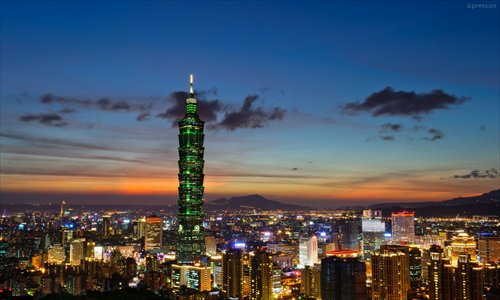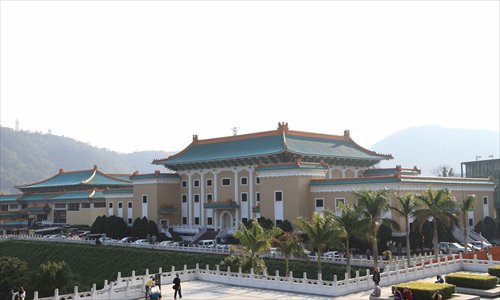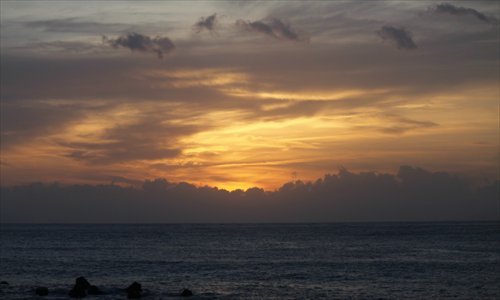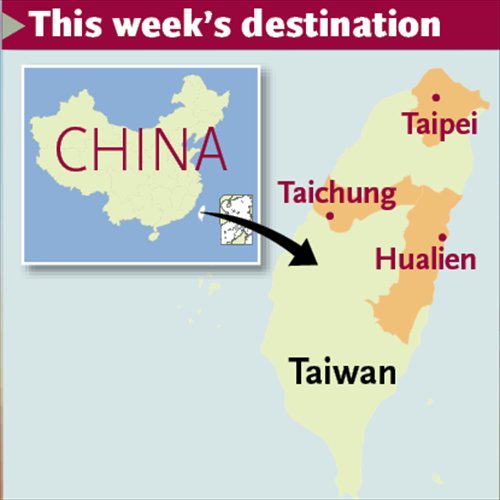Taiwan: Touch your heart
Enjoying the warmth of island culture

A view of the Taipei 101 in Taiwan Photo: CFP

Outside view of the "National Palace Museum" in Taiwan Photo: CFP

A view of the ocean sunrise in Hualien, Taiwan Photo: Chen Chenchen/GT

Graphics:GT
It's really convenient for Chinese mainlanders to go to Taiwan these days. Before leaving for the island during October's Golden Week holiday, the only thing I was worried about was whether or not I would find the island overwhelmed by mainland tourists. A friend assuaged my fears from the other side of the phone, "Don't worry, people will be scattered everywhere, and you'll have a wonderful, quiet trip." She was right. One week later after I came back, my hope was that in my next life I could be born on an island like Taiwan.
Three days in Taipei
I did my research in full before the trip, booking everything in advance and planning the whole journey one month before my departure. Online I found the verified Weibo account of a travel agency with more than 1 million followers that provides all kinds of tips and walkthroughs for traveling in Taiwan. By starting early, I was able to make reservations in advance for everything: a free guided tour of the "National Palace Museum," a free tour of Chinese painting guru Zhang Daqian's former residence and tickets for the "Presidential Office Building" in Taipei.
I also read a book on Taiwanese food and travel by writer Shu Guozhi, introducing the best, but not expensive food that could be found mainly in Taipei and a few other cities on the island. I marked all the places I could find on my road map with a star.
For historical reasons, Taipei has a subtle connection with the mainland city of Nanjing, where I attended university. Therefore, before my departure I already felt a sense of familiarity with the city.
The island didn't disappoint me at all. The temperature was a comfortable 25 C all day long. Meanwhile, Taipei, just like Nanjing, is just the right size - neither too small nor too big, which made getting around easy. Besides, the streets and alleys were covered by trees, which made leisure walks during the day or at night a perfect pleasure.
Most importantly, I could feel a sense of warm human kindness everywhere I went. In his book, Shu says that this human kindness is well represented in the food you can find at any random streetside food stall, as many restaurant owners belong to families that fled to Taiwan in the 1940s. After hurriedly settling down, these families gradually discovered that they wouldn't be able to return to their homes in the mainland, and so they focused on trying to recapture that feeling of their hometowns in their food, trying to recapture the flavors of the places they grew up.
This feeling of warmth isn't just found in the food, which is everywhere, but also in visits to tourist spots. For instance, take the three places I went on my trip, the "National Palace Museum," Zhang Daqian's former residence, and the "Presidential Office Building." At each of these places an expert guide was available to lead a small group of visitors on a free tour, explaining the various exhibits and telling us interesting historical anecdotes.
Back in Beijing, I often go to the National Museum of China, where there is an all-year exhibit of ancient Chinese treasures and cultural relics. Every visit has been a great pleasure, but as you go you start to feel that there is a sharp decline in the number of antiques and art work from the Ming (1368-1644) and Qing (1644-1911) dynasties. Due to historical reasons, many of these treasures are now in Taipei and one can spend the entire day just wandering the "National Palace Museum" enjoying them. One of the most interesting parts of the museum is on the ground floor, where there is a room dedicated to displaying antiques that came from the personal collection of Emperor Qianlong (reign: 1735-95). It wasn't until I was standing in front of them in complete astonishment that I realized how magnificent ancient Chinese craftsmanship could be, as the numerous carvings, paintings and other knick-knacks made me believe that art could outshine nature.
The museum is in northern part of Taipei, right below the beautiful Yanming mountains. Walking along the shadowy, quiet road in front of the museum for 15 minutes, you can reach the former residence of Zhang Daqian. Considering it's located down an alley, you'd have a hard time believing that it actually occupies an area of around 2,000 square meters. Zhang himself designed the gardens in this place. Sitting in one wooden pavilion, one becomes instantly intoxicated by the bubbling steam outside and the trees along the mountains.
Zhang was not just a greater painter, but also a gourmand and even greater cook. Through a large French window of his dining room, I could see the inner garden where all kinds of plants were growing, a perfect fit for the garden's bridge and running streams. A calligraphy work by Zhang, a menu containing a dozen dishes, hung on the wall. Zhang would hold private lunches here, cooking for his friends. Standing in that room - right beside the round, huge table and chairs where Zhang and his legendary friends once sat - and reading the name of the dishes they enjoyed, it was like walking back through time.
Actually, the entire city of Taipei gave me a similar feeling. In the downtown area, architecture from different eras - the Japanese occupation, local governance and the Kuomintang's arrival - are well preserved and still used today. Walking through the streets and alleys under the overhangs of old buildings, it was like walking through history.
Hualien moments
My train ride from Taipei to Hualien only took three hours. From my train window I could see the ocean, trees and low, clean residential houses. The heavy sense of history from Taipei gradually faded as I traveled east then south along the coast. Hualien, on the eastern coast line of the island, is different from Taipei, as it represents a relaxed, leisurely lifestyle.
Seaside scenic spots were far from each other. So I booked a driver to take us around that day from a local travel agency in advance. It turned out that the driver's jokes were the most interesting part of the day. He was from Pingtung, another city on the island, and was on loan to the Hualien branch of the travel agency for the busy season. The local accent has a special humor and tenderness to it, and with such an accent, he told jokes during our entire trip.
The best part of the natural scenery in Hualien is certainly the view of the ocean. The next day, I got up very early in the morning, walked from the hotel to the seaside to watch the sunrise. According to the Internet, that morning the sunrise was expected to take place at 5:37 am. There were a few runners on the seaside lane. My friend and I sat on some big rocks, in front of the extraordinarily blue sea. Waves came again and again, crashing against the rocks. Along the distant horizon a ship appeared, passing slowly from left to right. After a while a slim ray of white sunlight started to emerge through the clouds. Another brand-new day was about to begin. It was an extraordinarily peaceful yet exciting moment. It was like eternity was with us at that place in that moment.
One night in Taichung
Typhoons are frequent from June to October every year. So a morning boat, which I booked in advance to take us out to sea and see the whales, was canceled. We therefore took a train from Hualien to Taichung, the last stop on our Taiwan trip. Taichung is near to the Taiwan International Taoyuan Airport, where people can easily fly to other regions in the world.
The next morning we needed to catch an early bus to the airport and jump on to the flight back to Beijing, so we only had a few hours to spend in Taichung. Near to our hotel and right across the street was the old building that was the home for the Miyahara Eye Hospital during the Japanese colonial era. Today the building hosts a store that sells very well-known ice cream. We bought a three-scoop cup of ice cream, adding three kinds of toppings. A few others were sitting in the evening breeze under an overhang, enjoying their own smooth, sweet treats.
We later took a bus, running through the streets and alleys of Taichung, finally reaching the Feng Chia night market. There was a sea of people, enjoying food and chatting in front the tons of food stalls. Before a seafood stall, the owner said proudly that the two girls who just left the stall had come all the way from Taipei just to enjoy the food at his stall. He explained that he used to be a driver who worked in several cities on the island taking tourists around. So we naturally had to talk with him about some of the funny anecdotes he had from traveling around Taiwan. Listening to him I found that there were still plenty of other places on the island that I hadn't visited, and I promised myself there and then that I would definitely come back again someday.
Rules of thumb
1. Downloading several apps on your cellphone before going to Taiwan will make your trip way much easier. The "National Palace Museum" has its own official app that can guide you around the museum. There are also subway and bus apps, as well as apps telling you where good restaurants, post offices and shops are located.
2. Check the official website of the tourist spots you want to go - some places like the "National Palace Museum," residence of Zhang Daqian and the "Presidential Office Building" require you make appointments in advance for guided tours. Booking train tickets online early will also save you money.
3. Don't go to Taiwan if you are on a diet. Once you go, the only thing you'll regret is that you don't have a bigger stomach.